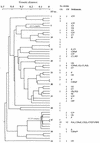Characterization of Neisseria meningitidis strains causing disease in complement-deficient and complement-sufficient patients
- PMID: 9666019
- PMCID: PMC105045
- DOI: 10.1128/JCM.36.8.2342-2345.1998
Characterization of Neisseria meningitidis strains causing disease in complement-deficient and complement-sufficient patients
Abstract
Serotyping and serosubtyping of meningococci showed no difference between isolates from 44 complement-deficient persons and from 50 complement-sufficient persons with meningococcal disease. Multilocus enzyme electrophoretic typing of the meningococci revealed 54 electrophoretic types that were equally distributed among isolates from complement-deficient and complement-sufficient patients. Analysis of strains isolated from eight complement-deficient persons with 11 recurrences of meningococcal disease showed that one strain was identical to the strain previously isolated from the same individual. Our results indicate that there are no differences between the clonal distributions of strains infecting complement-deficient and complement-sufficient patients. Most recurrences were infections caused by different strains.
Figures

Similar articles
-
Characterization of strains of Neisseria meningitidis recovered from complement-sufficient and complement-deficient patients in the Western Cape Province, South Africa.J Clin Microbiol. 1994 Sep;32(9):2185-91. doi: 10.1128/jcm.32.9.2185-2191.1994. J Clin Microbiol. 1994. PMID: 7814544 Free PMC article.
-
Assessment of complement deficiency in patients with meningococcal disease in The Netherlands.Clin Infect Dis. 1999 Jan;28(1):98-105. doi: 10.1086/515075. Clin Infect Dis. 1999. PMID: 10028078
-
Characterization of Neisseria meningitidis isolates and clinical features of meningococcal conjunctivitis in ten patients.Eur J Clin Microbiol Infect Dis. 1994 May;13(5):388-93. doi: 10.1007/BF01971995. Eur J Clin Microbiol Infect Dis. 1994. PMID: 8070451 Review.
-
Increase in moderate penicillin resistance and serogroup C in meningococcal strains isolated in Spain. Is there any relationship?Clin Infect Dis. 1994 Feb;18(2):161-5. doi: 10.1093/clinids/18.2.161. Clin Infect Dis. 1994. PMID: 8161621
-
Infection with uncommon subgroup Y Neisseria meningitidis in patients with systemic lupus erythematosus.Clin Exp Rheumatol. 1999 Nov-Dec;17(6):737-40. Clin Exp Rheumatol. 1999. PMID: 10609076 Review.
Cited by
-
A non membrane-targeted human soluble CD59 attenuates choroidal neovascularization in a model of age related macular degeneration.PLoS One. 2011 Apr 28;6(4):e19078. doi: 10.1371/journal.pone.0019078. PLoS One. 2011. PMID: 21552568 Free PMC article.
-
Infections of people with complement deficiencies and patients who have undergone splenectomy.Clin Microbiol Rev. 2010 Oct;23(4):740-80. doi: 10.1128/CMR.00048-09. Clin Microbiol Rev. 2010. PMID: 20930072 Free PMC article. Review.
-
Soluble CD59 expressed from an adenovirus in vivo is a potent inhibitor of complement deposition on murine liver vascular endothelium.PLoS One. 2011;6(6):e21621. doi: 10.1371/journal.pone.0021621. Epub 2011 Jun 24. PLoS One. 2011. PMID: 21720565 Free PMC article.
-
The first case report of complement component 7 deficiency in Qatar and a 10-year follow-up.Front Immunol. 2023 Oct 11;14:1253301. doi: 10.3389/fimmu.2023.1253301. eCollection 2023. Front Immunol. 2023. PMID: 37885879 Free PMC article.
-
Meningococcal disease and the complement system.Virulence. 2014 Jan 1;5(1):98-126. doi: 10.4161/viru.26515. Epub 2013 Oct 8. Virulence. 2014. PMID: 24104403 Free PMC article. Review.
References
-
- Broome, C. V. 1986. The carrier state: Neisseria meningitidis. J. Antimicrob. Chemother. 18(Suppl. A):25–34. - PubMed
-
- Cartwright K A V. Meningococcal carriage and disease. In: Cartwright K, editor. Meningococcal disease. Chichester, England: John Wiley & Sons Ltd.; 1995. pp. 115–146.
-
- Caugant D A, Bøvre K, Gaustad P, Bryn K, Holten E, Høiby E A, Frøholm L O. Multilocus genotypes determined by enzyme electrophoresis of Neisseria meningitidis isolated from patients with systemic disease and from healthy carriers. J Gen Microbiol. 1986;132:641–652. - PubMed
-
- Caugant D A, Bol P, Høiby E A, Zanen H C, Frøholm L O. Clones of serogroup B Neisseria meningitidis causing systemic disease in The Netherlands, 1958–1986. J Infect Dis. 1990;162:867–874. - PubMed
-
- Cunliffe N A, Snowden N, Dunbar E M, Haeney M R. Recurrent meningococcal septicaemia and properdin deficiency. J Infect. 1995;31:67–68. - PubMed
Publication types
MeSH terms
Substances
LinkOut - more resources
Full Text Sources
Medical

